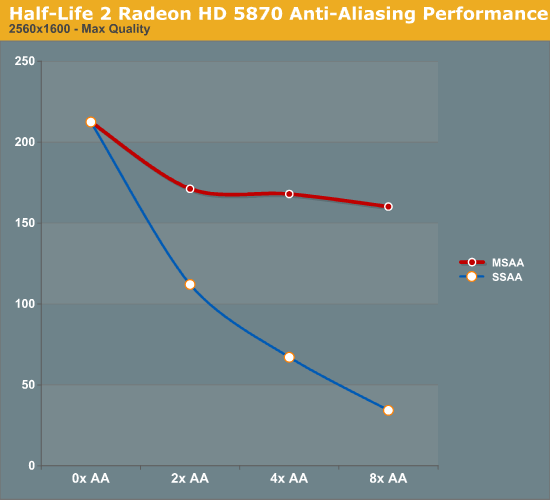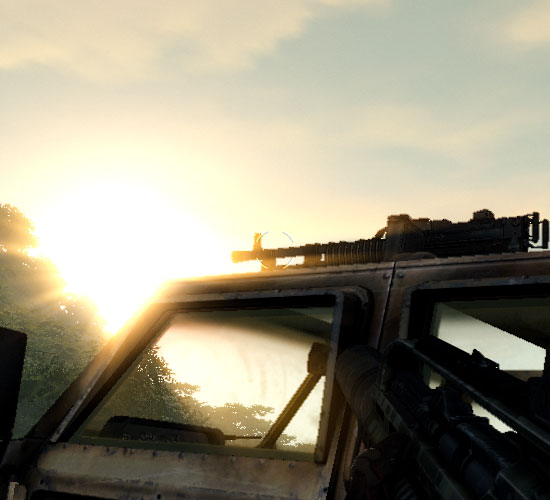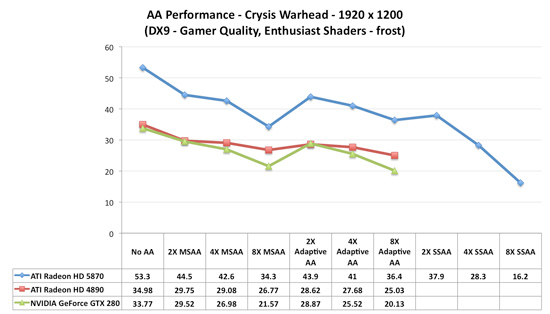AMD's Radeon HD 5870: Bringing About the Next Generation Of GPUs
by Ryan Smith on September 23, 2009 9:00 AM EST- Posted in
- GPUs
AA Image Quality & Performance
With HL2 unsuitable for use in assessing image quality, we will be using Crysis: Warhead for the task. Warhead has a great deal of foliage in parts of the game which creates an immense amount of aliasing, and along with the geometry of local objects forms a good test for anti-aliasing quality. Look in particular at the leaves both to the left and through the windshield, along with aliasing along the frame, windows, and mirror of the vehicle. We’d also like to note that since AMD’s SSAA modes do not work in DX10, this is done in DX9 mode instead.
|
AMD Radeon HD 5870
|
AMD Radeon HD 4870
|
NVIDIA GTX 280
|
| No AA | ||
| 2X MSAA | ||
| 4X MSAA | ||
| 8X MSAA | ||
| 2X MSAA +AAA | 2X MSAA +AAA | 2X MSAA + SSTr |
| 4X MSAA +AAA | 4X MSAA +AAA | 4X MSAA + SSTr |
| 8X MSAA +AAA | 8X MSAA +AAA | 8X MSAA + SSTr |
| 2X SSAA | ||
| 4X SSAA | ||
| 8X SSAA |
From an image quality perspective, very little has changed for AMD compared to the 4890. With MSAA and AAA modes enabled the quality is virtually identical. And while things are not identical when flipping between vendors (for whatever reason the sky brightness differs), the resulting image quality is still basically the same.
For AMD, the downside to this IQ test is that SSAA fails to break away from MSAA + AAA. We’ve previously established that SSAA is a superior (albeit brute force) method of anti-aliasing, but we have been unable to find any scene in any game that succinctly proves it. Shader aliasing should be the biggest difference, but in practice we can’t find any such aliasing in a DX9 game that would be obvious. Nor is Crysis Warhead benefitting from the extra texture sampling here.
From our testing, we’re left with the impression that for a MSAA + AAA (or MSAA + SSTr for NVIDIA) is just as good as SSAA for all practical purposes. Much as with the anisotropic filtering situation we know through technological proof that there is better method, but it just isn’t making a noticeable difference here. If nothing else this is good from a performance standpoint, as MSAA + AAA is not nearly as hard on performance as outright SSAA is. Perhaps SSAA is better suited for older games, particularly those locked at lower resolutions?
For our performance data, we have two cases. We will first look at HL2 on only the 5870, which we ran before realizing the quality problem with Source-engine games. We believe that the performance data is still correct in spite of the visual bug, and while we’re not going to use it as our only data, we will use it as an example of AA performance in an older title.

As a testament to the rendering power of the 5870, even at 2560x1600 and 8x SSAA, we still get a just-playable framerate on HL2. To put things in perspective, with 8x SSAA the game is being rendered at approximately 32MP, well over the size of even the largest possible single-card Eyefinity display.
Our second, larger performance test is Crysis: Warhead. Here we are testing the game on DX9 mode again at a resolution of 1920x1200. Since this is a look at the impact of AA on various architectures, we will limit this test to the 5870, the GTX 280, and the Radeon HD 4890. Our interest here is in performance relative to no anti-aliasing, and whether different architectures lose the same amount of performance or not.
Starting with the 5870, moving from 0x AA to 4x MSAA only incurs a 20% drop in performance, while 8x MSAA increases that drop to 35%, or 80% of the 4x MSAA performance. Interestingly, in spite of the heavy foliage in the scene, Adaptive AA has virtually no performance hit over regular MSAA, coming in at virtually the same results. SSAA is of course the big loser here, quickly dropping to unplayable levels. As we discussed earlier, the quality of SSAA is no better than MSAA + AAA here.
Moving on, we have the 4890. While the overall performance is lower, interestingly enough the drop in performance from MSAA is not quite as much, at only 17% for 4x MSAA and 25% for 8x MSAA. This makes the performance of 8x MSAA relative to 4x MSAA 92%. Once again the performance hit from enabling AAA is miniscule, at roughly 1 FPS.
Finally we have the GTX 280. The drop in performance here is in line with that of the 5870; 20% for 4x MSAA, 36% for 8x MSAA, with 8x MSAA offering 80% of the performance. Even enabling supersample transparency AA only knocks off 1 FPS, just like AAA under the 5870.
What this leaves us with are very curious results. On a percentage basis the 5870 is no better than the GTX 280, which isn’t an irrational thing to see, but it does worse than the 4890. At this point we don’t have a good explanation for the difference; perhaps it’s a product of early drivers or the early BIOS? It’s something that we’ll need to investigate at a later date.
Wrapping things up, as we discussed earlier AMD has been pitching the idea of better 8x MSAA performance in the 5870 compared to the 4800 series due to the extra cache. Although from a practical perspective we’re not sold on the idea that 8x MSAA is a big enough improvement to justify any performance hit, we can put to rest the idea that the 5870 is any better at 8x MSAA than prior cards. At least in Crysis: Warhead, we’re not seeing it.












327 Comments
View All Comments
avaughan - Wednesday, September 23, 2009 - link
Ryan,When you review the 5850 can you please specify memory size for all the comparison cards. At a guess the GTS 250 had 1GB and the 9800GT had 512 ?
Thanks
ThePooBurner - Wednesday, September 23, 2009 - link
With a full double the power and transistors and everything else including optimizations that should get more band for buck out of each one of those, why are we not seeing a full double the performance in games compared to the previous generation of cards?SiliconDoc - Wednesday, September 23, 2009 - link
Umm, because if you actually look at the charts, it's not "double everything".In fact, it's not double THE MOST IMPORTANT THING, bandwidth.
For pete sakes an OC'ed GTX260 core 192 get's to 154+ bandwidth rather easily, surpassing the 153.6 of ati's latest and greatest.
So, you have barely increased ram speed, same bus width... and the transistors on die are used up in "SHADERS" and ROPS....etc.
Where is all that extra shader processing going to go ?
Well, it goes to SSAA useage for instance, which provides ZERO visual quality improvement.
So, it goes to "cranking up the eye candy settings" at "not a very big framerate improvement".
--
So they just have to have a 384 or a 512 bus they are holding back. I dearly hope so.
They've already been losing a BILLION a year for 3+ years in a row, so the cost excuse is VERY VERY LAME.
I mean go check out the nvidia leaked stats, they've been all over for months - DDR5 and a 512 bit, with Multiple IMD, instead of the 5870 Single IMD.
If you want DOUBLE the performance wait for Nvidia. From DDR3 to DDR5, like going from 4850 to 4890, AND they (NVIDIA) have a whole new multiple instruction super whomp coming down the pike that is never done before, on their hated "gigantic brute force cores" (even bigger in the 40nm shrink -lol) that generally run 24C to 15C cooler than ati's electromigration heat generators.
---
So I mean add it up. Moving to DDR5, moving to multiple data, moving to 40nm, moving with 512 bit bus and AWESOME bandwidth, and the core is even bigger than the hated monster GT200. LOL
We're talking EPIC palmface.
--
In closing, buh bye ati !
silverblue - Thursday, September 24, 2009 - link
Let's wait for GT300 before we make any sweeping generalisations. The proof is in the pudding and it won't be long before we see it.And don't let the door hit you on the way out.
SiliconDoc - Thursday, September 24, 2009 - link
Oh mister, if we're waiting, that means NO BUYING the 5870, WAIT instead.Oh, yeah, no worries, it's not available.
---
Now, when my statements prove to be true, and your little crybaby snark with NO FACTS used for rebuttal are proven to be wasted stupidity, WILL YOU LEAVE AS YOU STATED YOU WANT ME TO ?
That's what I want to know. I want to know if your little wish applies to YOU.
Come on, I'll even accept a challenge on it. If I turn out to be wrong, I leave, if not you're gone.
If I'm correct, anyone waiting because of what I've pointed out, has been given an immense helping hand.
Which BY THE WAY, the entire article FAILED TO POINT OUT, because the red love goes so deep here.
-
But, you, the little red rooster ati fanner, wants me out.
ROFL - you people are JUST INCREDIBLE, it is absolutely incredible the crap you pull.
NOW, LET US KNOW WHAT LEAKED NVIDIA STATS I GOT INCORRECT WON'T YOU!?
No of course you won't !
silverblue - Friday, September 25, 2009 - link
Another problem I have with people like you is the unerring desire to rant and rave without reading things through. I said wait for GT300 before doing a proper comparison. Have you already forgotten the mess that was NV30? Paper specs do not necessarily equal reality. When the GT300 is properly previewed, even with an NDA in place, we can all judge for ourselves. People have a choice to buy what they like regardless of what you or I say.I'm not an ATI fanboy. I expended plenty of thought on what parts to get when I upgraded a few months back and that didn't just include CPU but motherboard and graphics. I was very close to getting a higher end Core2 Duo along with an nVidia graphics card; at the very least I considered an nVidia graphics card even when I decided on an AMD CPU and motherboard. In the end I felt I was getting better value by choosing an ATI solution. Doesn't make me a fanboy just because my money didn't end up on the nVidia balance sheet.
I'll take back the little comment about letting the door hit you on the way out. It wasn't designed to tell you to go away and not come back again, so my bad. I was annoyed at your ability to just attack a specific brand without any apparent form of objectivity. If you hate ATI, then you hate ATI, but do we really need to hear it all the time?
If the information you've posted about the GT300 is indeed accurate and comparable to what we've been told about the 58x0 series, then that's great, but you're going to need to lay it out in a more structured format so people can digest it more readily, as well as lay off the constant anti-ATI stance because appearing biased is not going to make people more receptive to your viewpoint. I remain sceptical that your leaked specs will end up being correct but in the end, GT300 is on its way and it'll be a monster regardless of whatever information you've posted here. I'm not going to pretend I know anything technical about GT300, but you must realise that what you've essentially done in this article is slate a working, existing product line that is being distributed to vendors as we speak in a manner that's much slower than ATI had intended yet you're attacking people for being interested in it over the GT300 which hasn't been reviewed yet, partly because you think the product is vapourware (which isn't really the case as people are getting hold of the 5870 but at a lower rate than ATI would like). Some people will choose to wait, some people will jump on the 58x0 bandwagon right now, but it's not for you to decide for them what they should buy.
Now relax, you're going to have a heart attack.
SiliconDoc - Wednesday, September 30, 2009 - link
What a LOAD OF CRAP.I don't have to outline anything, remember, ALL YOU PEOPLE cARE ABOUT IS GAMING FRAMERATE.
And that at "your price point" that doesn't include "the NVIDIA BALANCE SHEET". - which io of course, the STRANGEST WAY for a reddie to put it.
YOU JUST WANT ME TO SHUT UP. YOU DON'T WANT IT SAID. WE'LL I'M SAYING IT AGAIN, AND YOU FAILED TO ACCEPT MY CHALLENGE BECAUSE YOU'RE A CHICKEN, AND CENSOR !
---
Oh, do we have to hear it... blah blah blah blah...
--
YES SINCE THIS VERY ARTICEL WAS ABSOLUTELY IRRESPONSIBLE IN NOT PROPERLY ASSESSING THE COMPETITION.
CarrellK - Wednesday, September 23, 2009 - link
If a game ran almost entirely on the GPU, the scaling would be more of what you expect. You can put in a new GPU, but the CPU is no faster, main memory is no faster of bigger, the hard disk is no faster, PCIE is no faster, etc.The game code itself also limits scaling. For example the texture size can exceed the card's memory footprint, which results in performance sapping texture swaps. Each game introduces different bottlenecks (we can't solve them all).
We do our best to get linear scaling, but the fact is that we address less than a third of the game ecosystem. That we do better than 33% out of a possible 100% improvement is I think a testimony to our engineers.
BlackbirdCaD - Wednesday, September 23, 2009 - link
Why no load temp of 5870 in Crossfire??Load temp is much more important than idle temp.
There is lots of uninteresting stuff like soundlevel at idle with 5870 in crossfire, but the MOST IMPORTANT is missing: load temp with 5870 in crossfire.
SiliconDoc - Wednesday, September 23, 2009 - link
I just pulled up the chart on the 4870 CF, and although the 4870x2 was low 400's on load system power useage, the 4870 CF was 722 watts !So, I think your question may have some validity. I do believe the cards get a bit hotter in CF, and then you have the extra items on the PCB, the second slot used, the extra ram via the full amount on each card - all that adds up to more power useage, more heat in the case, and higher temps communicating with eachother. (resends for data on bus puases waitings, etc. ).
So there is something to your question.
---
Other than all that the basic answer is "red fan review site".
The ATI cards are HOTTER than the nvidia under load as a very, very wide general statement, that covers almost every card they both make, with FEW exceptions.